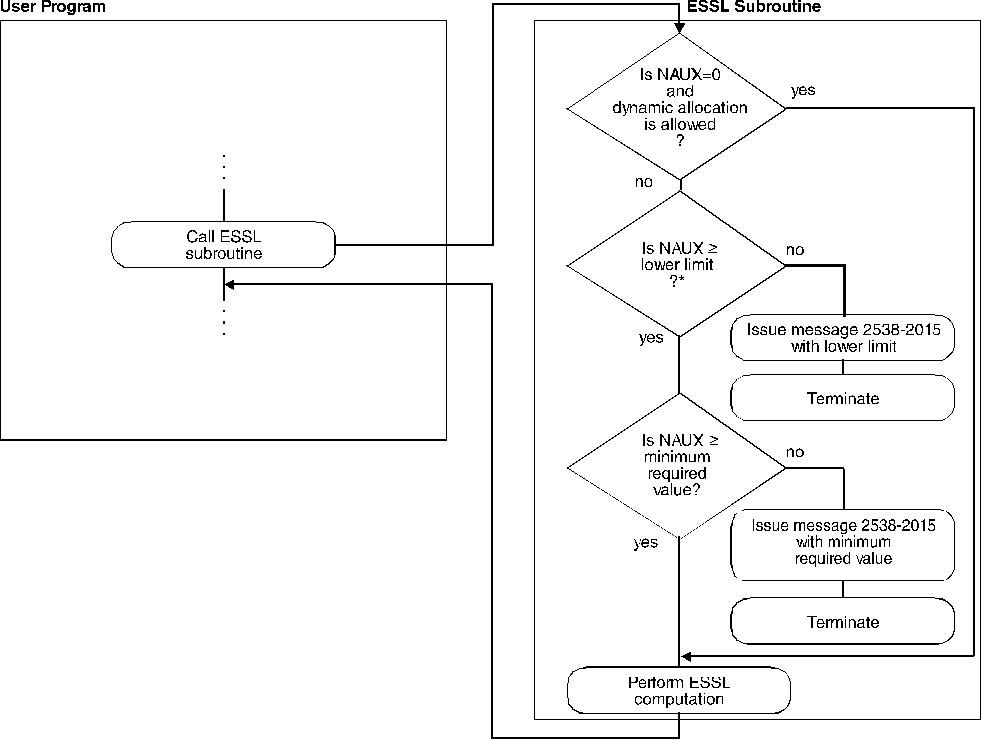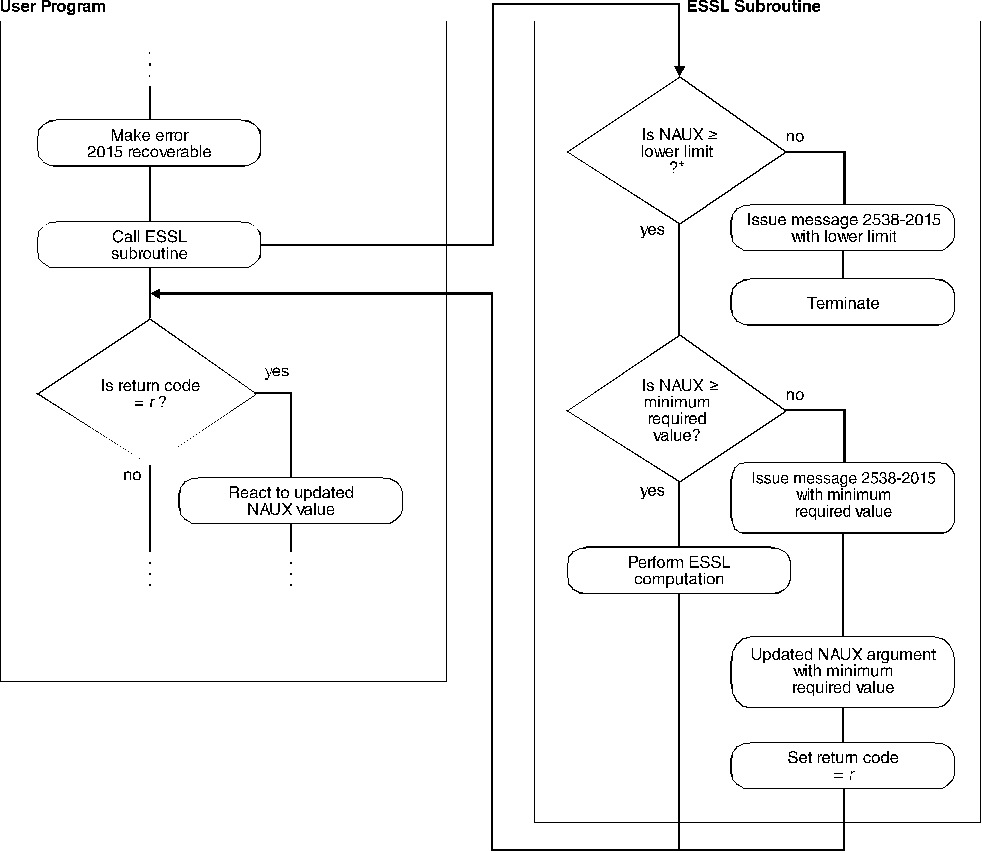
* This check applies only to several NAUX1 arguments in the Fourier transform, convolution, and correlation
subroutines.

For the ESSL subroutines listed in Table 22, you need to provide extra working storage to perform the computation. This section describes the use of dynamic allocation for providing auxiliary storage in ESSL and how to calculate the amount of auxiliary storage you need by use of formulas or error-handling capabilities provided in ESSL, if dynamic allocation is not an option.
Auxiliary storage, or working storage, is supplied through one or more
arguments, such as aux, in the calling sequence for the ESSL
subroutine. If the working storage does not need to persist after
the subroutine call, it is suggested you use dynamic allocation.
For example, in the Fourier Transforms subroutines, you may allocate
aux2 dynamically, but not aux1. See the subroutine
descriptions in Part 2 of this book for details and variations.
Table 22. ESSL Subroutines Requiring Auxiliary Working Storage
| Subroutine Names |
|---|
|
Linear Algebra Subprograms: DSMTM |
|
Matrix Operations: _GEMMS |
|
Dense Linear Algebraic Equations: _GEFCD _PPFCD _GEICD _PPICD _POFCD _POICD DGEFPDELTA DPPFPDELTA |
|
Sparse Linear Algebraic Equations: DGSF DGSS DGKFS DGKFSPDELTA DSKFS DSKFSPDELTA DSRIS DSMCG DSDCG DSMGCG DSDGCG |
|
Linear Least Squares: _GESVF _GELLS DGEQRF |
|
Eigensystem Analysis: _GEEV _SPEV _HPEV _SPSV _HPSV _GEGV _SYGV |
|
Fourier Transforms: _CFT _RCFT _CRFT _COSF _SINF SCOSFTDELTA _CFT2 _RCFT2 _CRFT2 _CFT3 _RCFT3 _CRFT3 SCFTPDELTA SCFT2PDELTA SCFT3PDELTA |
|
Convolutions and Correlations: SCONF SCORF SACORF |
|
Related Computations: _WLEV |
|
Interpolation: _TPINT _CSIN2 |
|
Random Number Generation: _NRAND |
|
Utilities: DGKTRN DSKTRN |
|
DELTA Documentation for this subroutine is no longer
provided. The aux and naux arguments for the
subroutine are specified the same as for the corresponding serial ESSL
subroutine.
|
Dynamic allocation for the auxiliary storage is performed when error 2015 is unrecoverable and naux=0. For details on which aux arguments allow dynamic allocation, see the subroutine descriptions in Part 2 of this book.
You set up the storage area in your program and pass it to ESSL through arguments, specifying the size of the aux work area in the naux argument.
You have a choice of two methods for determining how much auxiliary storage you should specify:
The formulas provided for calculating naux indicate a sufficient amount of auxiliary storage required, which, in most cases, is larger than the minimum amount, returned by ESSL error handling. There are two types of formulas:
These are given in the naux argument syntax descriptions. In general, these formulas result in the minimum required value, but, in a few cases, they provide overestimates.
These are given in separate sections in the subroutine description. In general, these provide overestimates.
Both types of formulas provide values that are sufficient for all processors. As a result, you can migrate to any other processor and to future releases of ESSL without being concerned about having to increase the amount of storage for aux. You do, of course, need to weigh your storage requirements against the convenience of using this larger value.
To calculate the amount of storage using the formulas, you must substitute values for specific variables, such as n, m, n1, or n2. These variables are arguments specified in the ESSL calling sequence or derived from the arguments in the calling sequence.
This section describes how you can get ESSL to calculate auxiliary storage.
Ask yourself which of the following ways you prefer to obtain the information from ESSL:
For both techniques, the amount returned by the ESSL error-handling facility is the minimum amount of auxiliary storage required to run your program successfully on the particular processor you are currently running on. The ESSL error-handling capability usually returns a smaller value than you derive by using the formulas listed for the subroutine. This is because the formulas provide a good estimate, but ESSL can calculate exactly what is needed on the basis of your data.
The values returned by ESSL error handling may not apply to future processors. You should not use them if you plan to run your program on a future processor. You should use them only if you are concerned with minimizing the amount of auxiliary storage used by your program.
In this case, you obtain the minimum required value of naux from the error message, but your program terminates. The following description assumes that dynamic allocation is not selected as an option.
Leave error 2015 as unrecoverable, without calls to EINFO and ERRSET. Run your program with the naux values smaller than required by the subroutine for the particular processor you are running on. As a general guideline, specify values smaller than those listed in the formulas. However, if a lower limit is specified in the syntax (only for several naux1 arguments in the Fourier transform, convolution, and correlation subroutines), you should not go below that limit. The ESSL error monitor returns the necessary sizes of the aux storage areas in the input-argument error message. This does, however, terminate your program when the error is encountered. (If you accidentally specify a sufficient amount of storage for the ESSL subroutine to perform the computation, error handling does not issue an error message and processing continues normally.) Figure 1 illustrates what happens when error 2015 is unrecoverable.
Figure 1. How to Obtain an NAUX Value from an Error Message, but Terminate
 * This check applies only to several NAUX1 arguments in the Fourier transform, convolution, and correlation subroutines. |
In this case, you obtain the minimum required value of naux from the error message and from the updated naux argument returned to your program.
Use EINFO and ERRSET with an ESSL error exit routine, ENOTRM, to make error 2015 recoverable. This allows you to dynamically determine in your program the minimum sizes required for the auxiliary working storage areas, specified in the naux arguments. Run your program with the naux values smaller than required by the subroutine for the particular processor you are running on. As a general guideline, specify values smaller than those listed in the formulas. However, if a lower limit is specified in the syntax (only for several naux1 arguments in the Fourier transform, convolution, and correlation subroutines), you should not go below that limit. The ESSL error monitor returns the necessary sizes of the aux storage areas in the input-argument error message and a return code is passed back to your program, indicating that updated values are also returned in the naux arguments. You can then react to these updated values during run time in your program. ESSL does not perform any computation when this error occurs. For details on how to do this, see Chapter 4, Coding Your Program. (If you accidentally specify a sufficient amount of storage for the ESSL subroutine to perform the computation, error handling does not issue an error message and processing continues normally.) Figure 2 illustrates what happens when error 2015 is recoverable.
Figure 2. How to Obtain an NAUX Value from an Error Message and in Your Program
 * This check applies only to several NAUX1 arguments in the Fourier transform, convolution, and correlation subroutines. |
The following example illustrates all the actions taken by the ESSL error-handling facility for each possible value of a recoverable input argument, naux. A key point here is that if you want to have the updated argument value returned to your program, you must make error 2015 recoverable and then specify an naux value greater than or equal to 20 and less than 300. For values out of that range, the error recovery facility is not in effect. (These values of naux, 20 and 300, are used only for the purposes of this example and do not relate to any of the ESSL subroutines.)
Table 23 describes the actions taken by ESSL in every possible
situation for the values given in this example.
Table 23. Example of Input-Argument Error Recovery for Auxiliary Storage Sizes
| NAUX Value | Action When 2015 Is an Unrecoverable Input-Argument Error | Action When 2015 Is a Recoverable Input-Argument Error |
|---|---|---|
| naux < 20 | An input-argument error message is issued. The value in the error message is the lower limit, 20. The application program stops. | An input-argument error message is issued. The value in the error message is the lower limit, 20. The application program stops. |
| 20 <= naux < 300 | An input-argument error message is issued. The value in the error message is the minimum required value, 300. The application program stops. | ESSL returns the value of naux as 300 to the application program, and an input-argument error message is issued. The value in the error message is the minimum required value, 300. ESSL does no computation, and control is returned to the application program. |
| naux >= 300 | Your application program runs successfully. | Your application program runs successfully. |
If you leave error 2015 unrecoverable, you do not code anything in your program. You just look at the error messages to get the sizes of auxiliary storage. On the other hand, if you want to make error 2015 recoverable to obtain the auxiliary storage sizes dynamically in your program, you need to add some coding statements to your program. For details on coding these statements in each programming language, see the following examples:
You may want to provide a separate subroutine to calculate the auxiliary storage size whenever you need it. Figure 3 shows how you might code a separate Fortran subroutine. Before calling SCFT in your program, call this subroutine, SCFT which calculates the minimum size and stores it in the naux arguments. Upon return, your program checks the return code. If it is nonzero, the naux arguments were updated, as planned. You should then make sure adequate storage is available and call SCFT. On the other hand, if the return code is zero, error handling was not invoked, the naux arguments were not updated, and the initialization step was performed for SCFT.
Figure 3. Fortran Subroutine to Calculate Auxiliary Storage Sizes
SUBROUTINE SCFT
* N, M, ISIGN, SCALE, AUX1, NAUX1,AUX2,NAUX2)
REAL*4 X(0:*),Y(0:*),SCALE
REAL*8 AUX1(7),AUX2(0:*)
INTEGER*4 INIT,INC1X,INC2X,INC1Y,INC2Y,N,M,ISIGN,NAUX1,NAUX2
EXTERNAL ENOTRM
CHARACTER*8 S2015
CALL EINFO(0)
CALL ERRSAV(2015,S2015)
CALL ERRSET(2015,0,-1,1,ENOTRM,0)
C SETS NAUX1 AND NAUX2 TO THE MINIMUM VALUES REQUIRED TO USE
C THE RECOVERABLE INPUT-ARGUMENT ERROR-HANDLING FACILITY
NAUX1 = 7
NAUX2 = 0
CALL SCFT(INIT,X,INC1X,INC2X,Y,INC1Y,INC2Y,
* N,M,ISIGN,SCALE,AUX1,NAUX1,AUX2,NAUX2,*10)
CALL ERRSTR(2015,S2015)
RETURN
10 CONTINUE
CALL ERRSTR(2015,S2015)
RETURN 1
END
|